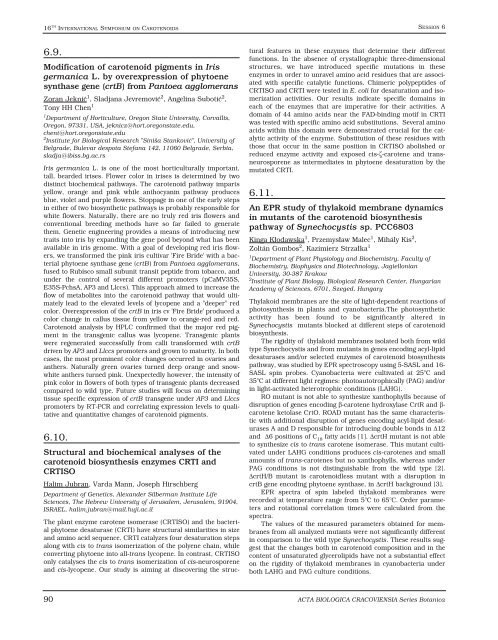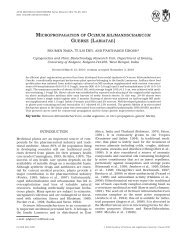ACTA BIOLOGICA CRACOVIENSIA
ACTA BIOLOGICA CRACOVIENSIA
ACTA BIOLOGICA CRACOVIENSIA
You also want an ePaper? Increase the reach of your titles
YUMPU automatically turns print PDFs into web optimized ePapers that Google loves.
16 TH INTERNATIONAL SYMPOSIUM ON CAROTENOIDS<br />
6.9.<br />
Modification of carotenoid pigments in Iris<br />
germanica L. by overexpression of phytoene<br />
synthase gene (crtB) from Pantoea agglomerans<br />
Zoran Jeknić1 , Sladjana Jevremović2 , Angelina Subotić2 ,<br />
Tony HH Chen1 1Department of Horticulture, Oregon State University, Corvallis,<br />
Oregon, 97331, USA, jeknicz@hort.oregonstate.edu,<br />
chent@hort.oregonstate.edu<br />
2Institute for Biological Research "Siniša Stanković", University of<br />
Belgrade, Bulevar despota Stefana 142, 11060 Belgrade, Serbia,<br />
sladja@ibiss.bg.ac.rs<br />
Iris germanica L. is one of the most horticulturally important,<br />
tall, bearded irises. Flower color in irises is determined by two<br />
distinct biochemical pathways. The carotenoid pathway imparts<br />
yellow, orange and pink while anthocyanin pathway produces<br />
blue, violet and purple flowers. Stoppage in one of the early steps<br />
in either of two biosynthetic pathways is probably responsible for<br />
white flowers. Naturally, there are no truly red iris flowers and<br />
conventional breeding methods have so far failed to generate<br />
them. Genetic engineering provides a means of introducing new<br />
traits into iris by expanding the gene pool beyond what has been<br />
available in iris genome. With a goal of developing red iris flowers,<br />
we transformed the pink iris cultivar 'Fire Bride' with a bacterial<br />
phytoene synthase gene (crtB) from Pantoea agglomerans,<br />
fused to Rubisco small subunit transit peptide from tobacco, and<br />
under the control of several different promoters (pCaMV35S,<br />
E35S-PchsA, AP3 and Llccs). This approach aimed to increase the<br />
flow of metabolites into the carotenoid pathway that would ultimately<br />
lead to the elevated levels of lycopene and a "deeper" red<br />
color. Overexpression of the crtB in iris cv 'Fire Bride' produced a<br />
color change in callus tissue from yellow to orange-red and red.<br />
Carotenoid analysis by HPLC confirmed that the major red pigment<br />
in the transgenic callus was lycopene. Transgenic plants<br />
were regenerated successfully from calli transformed with crtB<br />
driven by AP3 and Llccs promoters and grown to maturity. In both<br />
cases, the most prominent color changes occurred in ovaries and<br />
anthers. Naturally green ovaries turned deep orange and snowwhite<br />
anthers turned pink. Unexpectedly however, the intensity of<br />
pink color in flowers of both types of transgenic plants decreased<br />
compared to wild type. Future studies will focus on determining<br />
tissue specific expression of crtB transgene under AP3 and Llccs<br />
promoters by RT-PCR and correlating expression levels to qualitative<br />
and quantitative changes of carotenoid pigments.<br />
6.10.<br />
Structural and biochemical analyses of the<br />
carotenoid biosynthesis enzymes CRTI and<br />
CRTISO<br />
Halim Jubran, Varda Mann, Joseph Hirschberg<br />
Department of Genetics, Alexander Silberman Institute Life<br />
Sciences, The Hebrew University of Jerusalem, Jerusalem, 91904,<br />
ISRAEL, halim.jubran@mail.huji.ac.il<br />
The plant enzyme carotene isomerase (CRTISO) and the bacterial<br />
phytoene desaturase (CRTI) have structural similarities in size<br />
and amino acid sequence. CRTI catalyzes four desaturation steps<br />
along with cis to trans isomerization of the polyene chain, while<br />
converting phytoene into all-trans lycopene. In contrast, CRTISO<br />
only catalyses the cis to trans isomerization of cis-neurosporene<br />
and cis-lycopene. Our study is aiming at discovering the struc-<br />
SESSION 6<br />
tural features in these enzymes that determine their different<br />
functions. In the absence of crystallographic three-dimensional<br />
structures, we have introduced specific mutations in these<br />
enzymes in order to unravel amino acid residues that are associated<br />
with specific catalytic functions. Chimeric polypeptides of<br />
CRTISO and CRTI were tested in E. coli for desaturation and isomerization<br />
activities. Our results indicate specific domains in<br />
each of the enzymes that are imperative for their activities. A<br />
domain of 44 amino acids near the FAD-binding motif in CRTI<br />
was tested with specific amino acid substitutions. Several amino<br />
acids within this domain were demonstrated crucial for the catalytic<br />
activity of the enzyme. Substitution of these residues with<br />
those that occur in the same position in CRTISO abolished or<br />
reduced enzyme activity and exposed cis-ζ-carotene and transneurosporene<br />
as intermediates in phytoene desaturation by the<br />
mutated CRTI.<br />
6.11.<br />
An EPR study of thylakoid membrane dynamics<br />
in mutants of the carotenoid biosynthesis<br />
pathway of Synechocystis sp. PCC6803<br />
Kinga Kłodawska1 , Przemysław Malec1 , Mihály Kis2 ,<br />
Zoltán Gombos2 , Kazimierz Strzałka1 1Department of Plant Physiology and Biochemistry, Faculty of<br />
Biochemistry, Biophysics and Biotechnology, Jagiellonian<br />
University, 30-387 Krakow<br />
2Institute of Plant Biology, Biological Research Center, Hungarian<br />
Academy of Sciences, 6701, Szeged, Hungary<br />
Thylakoid membranes are the site of light-dependent reactions of<br />
photosynthesis in plants and cyanobacteria.The photosynthetic<br />
activity has been found to be significantly altered in<br />
Synechocystis mutants blocked at different steps of carotenoid<br />
biosynthesis.<br />
The rigidity of thylakoid membranes isolated both from wild<br />
type Synechocystis and from mutants in genes encoding acyl-lipid<br />
desaturases and/or selected enzymes of carotenoid biosynthesis<br />
pathway, was studied by EPR spectroscopy using 5-SASL and 16-<br />
SASL spin probes. Cyanobacteria were cultivated at 25°C and<br />
35°C at different light regimes: photoautotrophically (PAG) and/or<br />
in light-activated heterotrophic conditions (LAHG).<br />
RO mutant is not able to synthesize xanthophylls because of<br />
disruption of genes encoding β-carotene hydroxylase CrtR and βcarotene<br />
ketolase CrtO. ROAD mutant has the same characteristic<br />
with additional disruption of genes encoding acyl-lipid desaturases<br />
A and D responsible for introducing double bonds in Δ12<br />
and Δ6 positions of C 18 fatty acids [1]. ΔcrtH mutant is not able<br />
to synthesize cis to trans carotene isomerase. This mutant cultivated<br />
under LAHG conditions produces cis-carotenes and small<br />
amounts of trans-carotenes but no xanthophylls, whereas under<br />
PAG conditions is not distinguishable from the wild type [2].<br />
ΔcrtH/B mutant is carotenoidless mutant with a disruption in<br />
crtB gene encoding phytoene synthase, in ΔcrtH background [3].<br />
EPR spectra of spin labeled thylakoid membranes were<br />
recorded at temperature range from 5°C to 65°C. Order parameters<br />
and rotational correlation times were calculated from the<br />
spectra.<br />
The values of the measured parameters obtained for membranes<br />
from all analyzed mutants were not significantly different<br />
in comparison to the wild type Synechocystis. These results suggest<br />
that the changes both in carotenoid composition and in the<br />
content of unsaturated glycerolipids have not a substantial effect<br />
on the rigidity of thylakoid membranes in cyanobacteria under<br />
both LAHG and PAG culture conditions.<br />
90 <strong>ACTA</strong> <strong>BIOLOGICA</strong> <strong>CRACOVIENSIA</strong> Series Botanica












